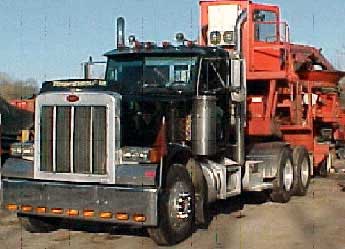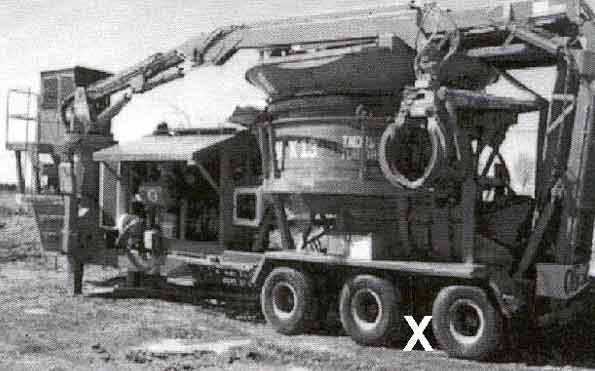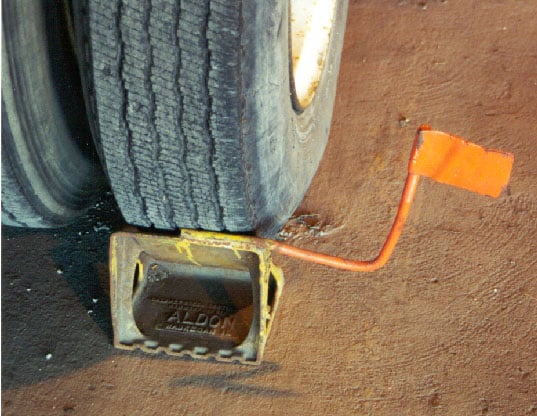Sixteen-Year-Old Mechanic’s Assistant Died After Being Run Over By the Rear Wheels of a Tub Grinder – Connecticut
NIOSH In-house FACE Report 2000-14
Summary
On March 13, 2000, a 16-year-old male mechanic’s assistant (the victim) died after he was run over by the rear wheels of a trailer-mounted tub grinder (a machine used to grind large volumes of wood for waste disposal, reduction, and recycling). The victim was a high school student and had been working for the company, a tree removal, wood waste processing and logging enterprise, on a part-time basis for 9 months. The victim worked at the company yard where wood waste was processed and vehicles maintained and repaired. On the day of the incident the tub grinder had been connected to a truck/tractor for transport to another job site and was parked in front of the company’s garage with the truck engine idling. The victim was working in the yard near the garage while a mechanic was under the tub grinder repairing a trailer wheel’s air brake system. When the mechanic crawled out from under the tub grinder and went to obtain a wrench of another size, the victim crawled under the tub grinder between the first and second axle with his own wrench. The truck/tractor driver, seeing the mechanic walk away, drove the vehicle forward, toward the refueling area, dragging and then running over the victim. Emergency rescue personnel were called immediately and arrived at the site within minutes. The victim was pronounced dead at the site. NIOSH investigators concluded that, to help prevent similar occurrences, employers should:
- develop, implement, and enforce standard operating procedures for repair work performed under vehicles
- provide workers with training in recognition of unsafe conditions and the required work practices that apply to their work environment
- know and comply with child labor laws which include prohibitions against work by youth less than 18 years of age in occupations which are declared by the Secretary of Labor to be particularly hazardous (Hazardous Orders)
Introduction
On March 13, 2000, a 16-year-old male mechanic’s assistant (the victim) died after he was run over by the second axle wheels of a three axle, trailer-mounted tub grinder. On March 17, 2000, officials of the Wage and Hour Division of the U.S. Department of Labor notified the Division of Safety Research (DSR) of this fatality. On April 20, 2000, a DSR occupational safety and health specialist met with personnel from the U.S. Department of Labor, Wage and Hour Division; the State Department of Labor, Wage and Workplace Standards Division; and the U.S. Occupational Safety and Health Administration (OSHA) to discuss the case. Official investigative reports and photographs from the police department and the medical examiner’s office were reviewed. The employer declined an interview.
During the course of the investigation the DSR investigator viewed photographs of the tub grinder but was unable to gain access to view the tub grinder used in the incident. Product specifications and a photograph of a tub grinder similar to the model involved in the incident were obtained from the manufacturer’s internet web site.
The employer had operated a tree removal, wood waste processing, and logging business for 11 years. At the time of the incident, the company employed 6 employees, including office staff. The victim was the only employee working for the company who was under 18 years of age. According to OSHA findings, the employer did not have a written safety plan and there was no evidence that training in hazard awareness, avoidance, or abatement had been provided to the employees. The victim had worked for the company for approximately 9 months, having worked full time in the summer of 1999. During the school year, the victim worked on Saturdays, after school, and during the day when school was not in session. The victim’s jobs included general cleanup duties in the garage and yard, assisting other employees with minor repairs and maintenance on vehicles and equipment, and wood splitting. This was the first fatality experienced by the employer.
Back to Top
Investigation
On the day of the incident, the employer had been contracted to remove trees and grind scrap wood at an off-site location. To complete the job, the trailer-mounted tub grinder that had been used in the yard for the past month was being prepared for highway transport. The tub grinder weighed 74,000 pounds and had a completely portable 5th wheel transport system. It was designed for disposal, reduction, and recycling of industrial-volume wood waste.
The crew arrived at work at approximately 6:00 a.m. and included a mechanic, crew foreman, two truck/tractor drivers, an office worker, and the victim. One of the truck drivers, the victim’s stepfather, left the yard for his first delivery assignment soon after their arrival. After the employer called in to assign the crew’s work for the day, the victim began doing yard cleanup. The yard foreman went to the paved lot at the front of the yard and began loading an excavator onto a lo-boy flatbed trailer. Meanwhile, the mechanic drove his service truck and the truck driver drove the Peterbilt truck/tractor to the rear of the yard near an abandoned concrete silo where the trailer-mounted tub grinder had been set up. Using an older model Mack truck/tractor, they towed the tub grinder about 30 feet, then replaced the truck/tractor with a 1995 Peterbilt 379 diesel truck/tractor in preparation for transporting the tub grinder (Photo 1). The truck driver drove the truck/tractor and trailer-mounted tub grinder approximately 400 feet to a location in front of one of the garage bays. The truck/tractor’s engine was idling and the truck/tractor and trailer-mounted tub grinder were parked on a flat dry dirt road with the truck/tractor angled slightly to the right.
At this time, the mechanic planned to tighten a plug on an airbrake canister on the trailer prior to refueling and taking the trailer-mounted tub grinder off site. The victim, who had been performing cleaning duties, began picking metal rods out of a nearby garbage dumpster and carrying them across the dirt road and depositing them into empty oil containers located near the rear of the tub grinder. According to the police report, the following series of events occurred. The victim stood behind his coworkers and watched while the mechanic crawled under the tub grinder to tighten a bolt on the driver’s side, third axle air brake canister. Realizing he had the wrong size wrench, the mechanic crawled out from under the tub grinder and went to retrieve a wrench of the correct size. After the mechanic crawled out from under the grinder, the victim apparently crawled under it, in front of the second axle, with a wrench in his hand. After the driver saw the mechanic crawl out from under the tub grinder he got into his truck and, unaware of the victim’s presence under the tub grinder, drove toward the refueling area. The driver reported to the police, after the incident, that the truck/tractor was parked angled slightly to the right, and the rear of the trailer was not visible in the side mirror. As the truck moved forward, the mechanic saw the victim’s legs extending out from under the tub grinder and yelled for the driver to stop. The driver stopped the truck after it had traveled approximately 28 feet, got out, and went with the mechanic to the rear of the tub grinder. There they saw the victim lying beneath and slightly in front of the tub grinder’s third axle wheels, on the driver’s side (see Photo 2 for the approximate location of victim under the wheels of the trailer-mounted tub grinder). A business owner working nearby heard screams around 7 a.m. and ran over to see what had happened. He saw the victim’s body under the wheels of the trailer and immediately called 911. Coworkers notified the employer, who was not on site, and the crew foreman, who had been working in the paved lot in the front of the yard loading an excavator onto a lo-boy flatbed trailer, of the incident. Emergency rescue personnel arrived at the site within minutes and determined that the victim’s injuries had been immediately fatal. Police records indicate that the victim was run over and then dragged between the second axle wheels and the third axle wheels of the tub grinder before the truck could be stopped. A crane was used to lift the 74,000 pound tub grinder off the victim’s chest. The victim was pronounced dead at the site at 8:30 a.m.
Police officials requested an inspection of the truck/tractor and tub grinder following the incident and, after reviewing the results of the inspection, determined that the condition of the vehicles did not contribute to the incident.
Back to Top
Cause of Death
The Medical Examiner listed the cause of death as compression and blunt force trauma of the chest.
Recommendations and Discussion
Recommendation #1: Employers should develop, implement, and enforce standard operating procedures for repair work performed under vehicles.
Discussion: Standard operating procedures should be developed, implemented, and enforced, which include safety procedures that should be followed when equipment maintenance or repair requires workers to be located under or near parked vehicles. The procedures should include, at minimum, the type of system employees are to use to identify equipment under repair, the measures they are to utilize to prevent unexpected movement of equipment under repair, and the method employees are to use to communicate among themselves regarding the planned maintenance and repair work and their specific tasks and responsibilities. A pre-maintenance, pre-work meeting should be held with all involved workers to outline/review the procedures to be used during maintenance activities and to outline/review each worker’s specific responsibilities and tasks. At a minimum, prior to beginning repairs under parked vehicles, the mechanic and truck driver should go over the steps required in the repair process and develop a system for ongoing verbal and visual communication throughout the repair process. Steps may include the following: shutting off the engine; placing the shift lever in park if there is a park position or, if there is no park position, placing the shift lever in the lowest possible gear; applying the parking brake; placing a warning tag on the vehicle near the controls which indicates that it is under repair; and placing chocks, one in front and one behind, the drive axle tires. Following repairs, the mechanic, driver, and supervisor should conduct a walk-around inspection to make certain that the area under and around the vehicle is clear of people and property. Only after the inspection should the chocks and the warning tag be removed, and the driver given clearance to move the vehicle. An employee should be assigned the duties of spotter and, in full view of the driver and well away from the travel path of the vehicle, should direct the driver from the area where maintenance and repair work was completed.
Employers can use selected portions of the Occupational Safety and Health Administration (OSHA) Lockout/Tagout of Hazardous Energy (1910.147) standard for guidance regarding the use of tags as a visual warning that equipment is under repair and thus should not be moved. Although this standard was not written to address the safety of workers performing repairs under motor vehicles, it provides valuable guidance for employers to safeguard workers engaged in these types of repair operations.
The comprehensive truck inspection program developed by the Commercial Vehicle Safety Alliance (CVSA) includes useful information regarding protection for inspectors who must go under trucks to complete a Level I truck inspection. This information may be useful to employers developing standard operating procedures for repair work under vehicles. Prior to a Level I inspection, the vehicle is to be parked on a flat and solid surface, the truck’s engine shut off, and chocks placed one in front and one behind the drive axle tires. The inspector communicates verbally with the driver about each step of the inspection process, and there is both verbal and visual communication between the inspector and the driver whenever the inspector is required to go under the vehicle to complete specific parts of the inspection. Employers may choose to use some of the steps found in the CVSA Level I truck inspection process in developing their standard operating procedures for working under vehicles (see http://www.cvsa.org/home.phpexternal icon). (Link updated 4/8/2013)
As an additional precaution, employers may choose to purchase steel wheel chocks that have had a flag welded to them by the manufacturer (see Photo 3). The flag, when painted a bright fluorescent color such as red, orange, or yellow, makes the chock more visible to workers in the area and alerts them that maintenance is being performed. Note: The flag on the chocks would not replace the warning tag system placed near the vehicle’s controls mentioned earlier, but could provide a redundant measure to alert workers that repairs are in process.
Recommendation #2: Employers should provide workers with training in recognition of unsafe conditions and the required work practices that apply to their work environment.
Discussion: Training in recognizing hazards should be given to all workers, coupled with employer assessments that workers are competent in the recognition of hazards and safe work practices.
Youth less than 18 years of age and workers assigned to work with young workers should receive training on prohibited work tasks and settings (activities deemed to be especially hazardous by employer/child labor regulations) as well as hazards and safe work practices that apply to work they are permitted to perform.
Recommendation #3: Employers should know and comply with child labor laws which include prohibitions against work by youth less than 18 years of age in occupations which are declared by the Secretary of Labor to be particularly hazardous (Hazardous Orders).
Discussion: The Fair Labor Standards Act provides a minimum age of 18 years for work which the Secretary of Labor declares to be particularly hazardous. Currently, there are 17 Hazardous Orders. One of the 17 Hazardous Orders prohibits minors from working in occupations involved in the operation of power-driven wood working machines (Hazardous Order No.5). More specifically, Hazardous Order #5, item 2, prohibits minors from working in occupations of setting up, repairing, oiling or cleaning power-driven wood working machines. The victim’s activities at the time of the fatal incident fell under the prohibited tasks in Hazardous Order #5. Employers who employ workers less than 18 years of age should contact the U.S. Department of Labor, Wage and Hour Division, and the agency in their State that regulates child labor to obtain information regarding appropriate work for young workers. Once this information is obtained, employers should ensure that the specific duties assigned to young workers are in compliance with the law and that their entire workforce is informed about these specific duties as well. Employers should post a list of the 17 Hazardous Orders at a location in the workplace where it is accessible to the entire workforce. This posting would serve as a reminder to the workforce regarding the type of work that is considered hazardous for young workers and is thus prohibited.
References
- DOL (1990b). Child labor requirements in nonagricultural occupations under the Fair Labor Standards Act. Washington D.C.: U.S. Department of Labor, Employment Standards Administration, Wage and Hour Division WH 1330.
- Code of Federal Regulations 29 CFR 1910.147, 1999 edition. U.S. Government Printing Office, Office of the Federal Register, Washington, D.C.
- http://www.cvsa.org/home.phpexternal icon (Link updated 4/8/2013)
Investigator Information
This investigation was conducted by Doloris N. Higgins, Occupational Safety and Health Specialist, NIOSH, Division of Safety Research, Surveillance and Field Investigation Branch, Fatality Assessment and Control Evaluation Team.
Back to Top
Photographs

|

|

|
|
Photo 3. Wheel Chocks With a Flag. A metal flag welded onto
a metal chock allows for greater visibility. (Photograph courtesy of George Swartz, CSP) |
The FACE investigation project is the cornerstone of the overall NIOSH program to prevent occupational fatalities. The objectives for this effort include the investigation of occupational fatalities to assess and characterize the circumstances of these events in order to develop succinct descriptive and evaluative reports for distribution to occupational safety and health groups across the country. This work is being conducted by the FACE investigation team. It is expected that the reports alone will have a major impact by better defining the causal factors behind occupational fatalities, calling national attention to the problem, and providing insights into the prevention efforts that are needed. However, the program does not determine fault or place blame on companies or individual workers.
